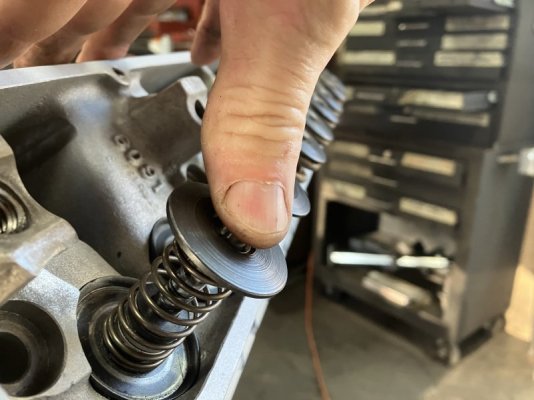Geoff 2
Well-Known Member
Kern,
Two comments:-
-I always get a chuckle when I see people going to the nth degree [ pardon the pun ] to degree their cam. "So #1 is exactly at 4* adv where I want it". What about the other 7 cyls [ if it is a 8 cyl ]??
- if you are pretty sure you have plenty of V to P clearance, but just want to check to make sure, you can do this. Assemble the heads & bolt in place with head gasket, but bolts not torqued, just nipped up. Pick which valve, I or E, you want to check. Use a solid lifter or a bottomed out hyd lifter & take up the lash. Rotate the crank until you are at overlap, TDC. Valve will be open slightly. Next step is easier if you have a helper. Measure from the spring pad to the retainer. Using a pair of multi-grips or similar, lever on the prod side of the rocker to push the valve into the piston; while holding in this position, measure spring pad to retainer again. The difference between the two measurements is the V to P clearance. If you have 0.150" or more, job done, head bolts can be torqued. If less, then the procedure should be repeated @ 10* BTDC for the exh valve & 10* ATDC for the intake. This is because with some fast acting cams, combined with some rod/stroke ratios, the valves are closer to the piston than at TDC. Good luck.
Two comments:-
-I always get a chuckle when I see people going to the nth degree [ pardon the pun ] to degree their cam. "So #1 is exactly at 4* adv where I want it". What about the other 7 cyls [ if it is a 8 cyl ]??
- if you are pretty sure you have plenty of V to P clearance, but just want to check to make sure, you can do this. Assemble the heads & bolt in place with head gasket, but bolts not torqued, just nipped up. Pick which valve, I or E, you want to check. Use a solid lifter or a bottomed out hyd lifter & take up the lash. Rotate the crank until you are at overlap, TDC. Valve

















